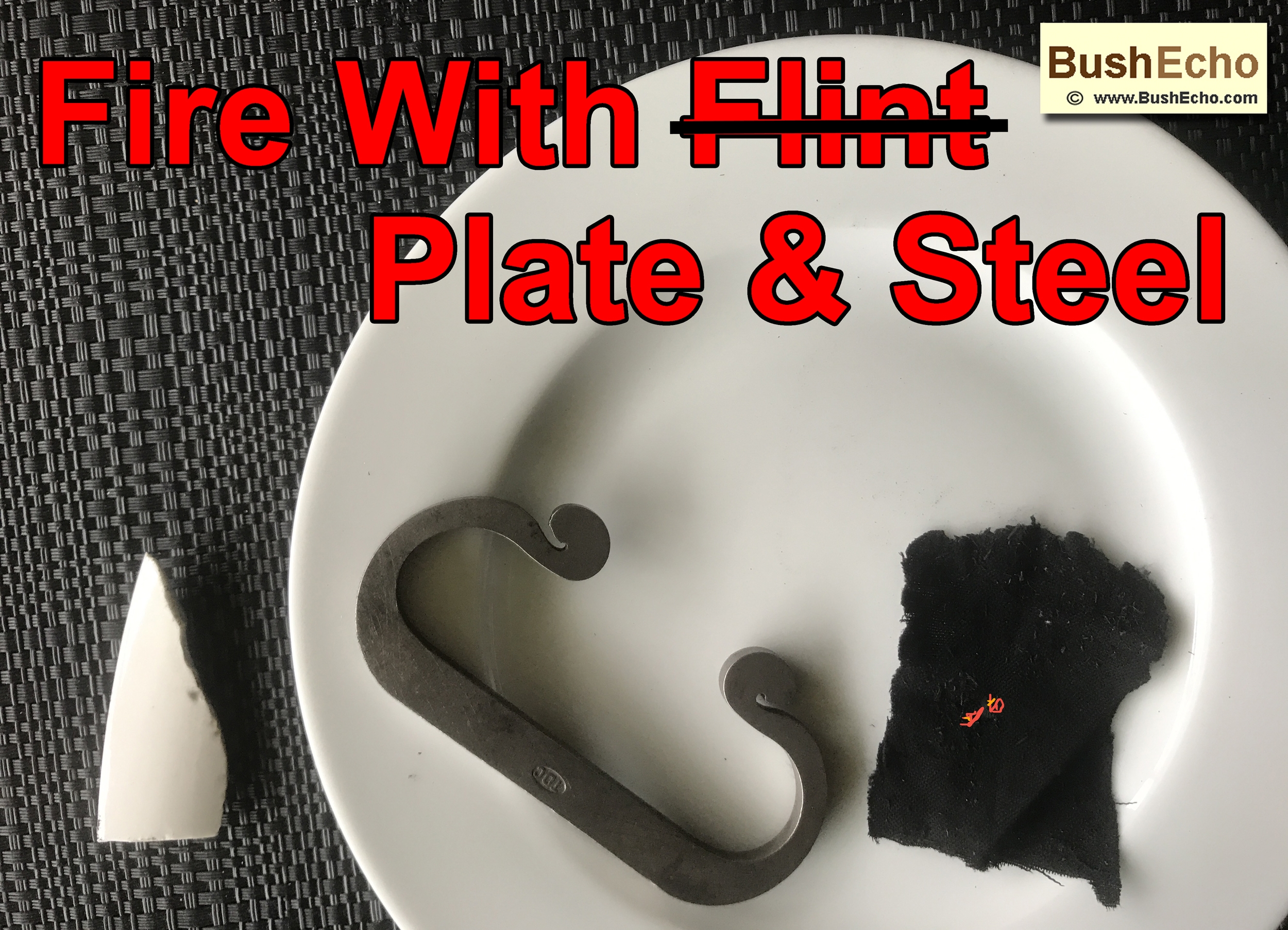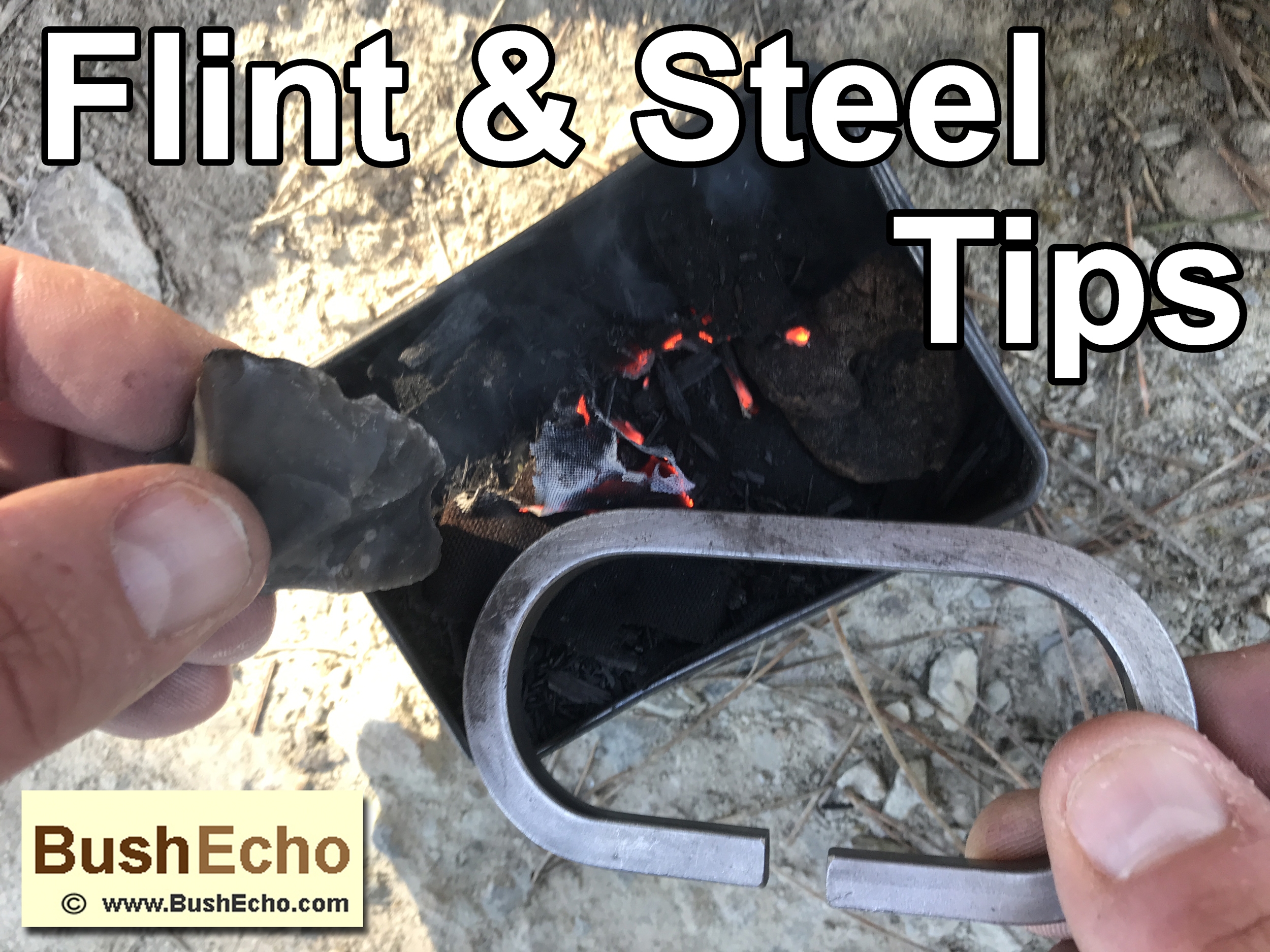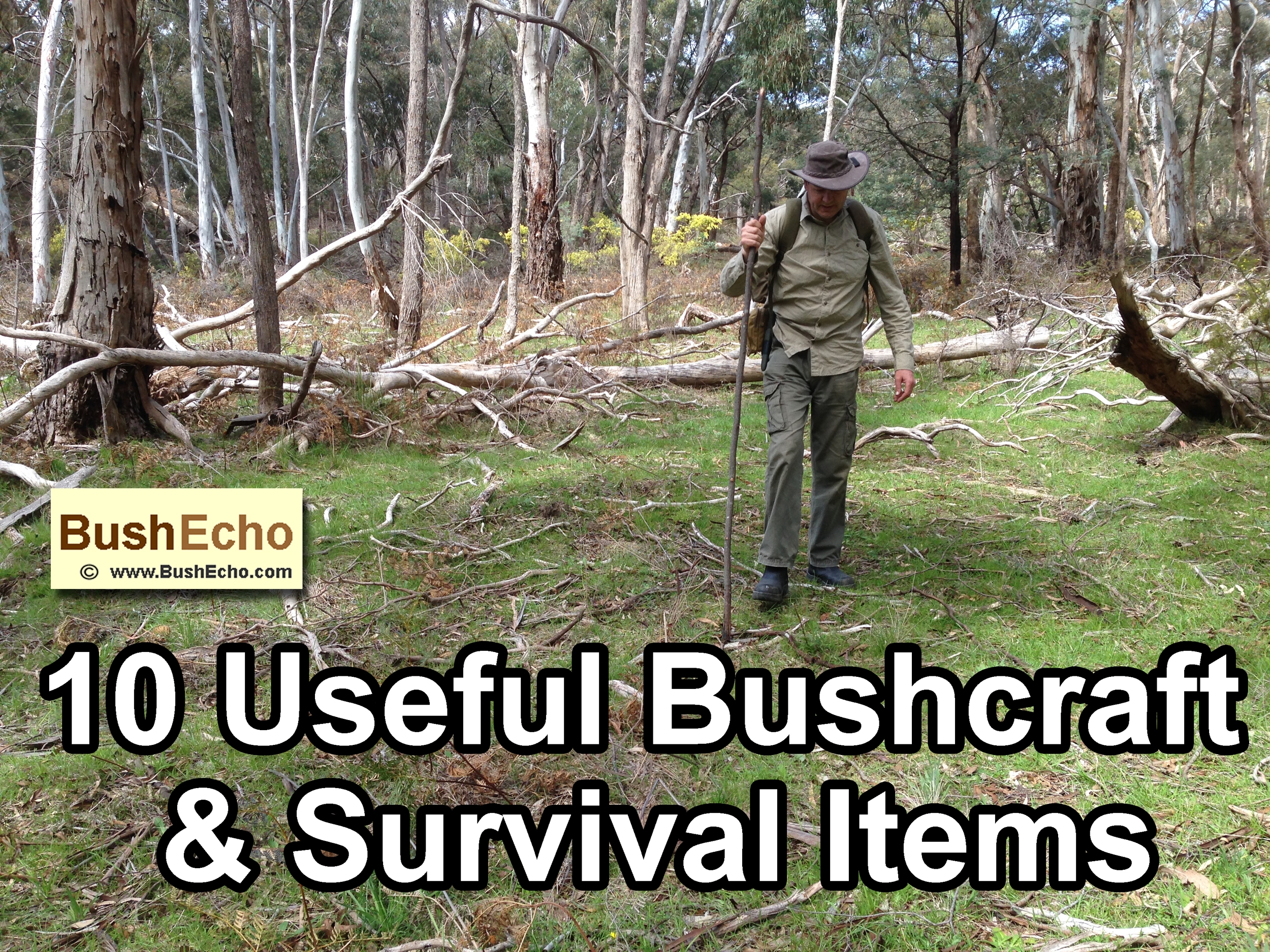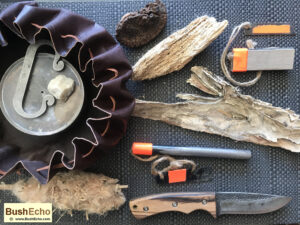
With the many bushcraft fire-lighting tools around, it can be a bit confusing about the names and correct terms of each one.
In some outdoor YouTube channels and survival shows, there seems to be a misunderstanding about what fire lighting tools are what. Some shows are mistakenly calling the ferrocerium rod and magnesium bar, a flint and steel.
Added to the confusion are some big name camping stores market the tools under other labels.
In this article we will look at the difference between the flint & steel, ferrocerium rod and the magnesium bar fire starter. As well as cover the basic function and a few bushcraft tips of each fire-lighting tool.
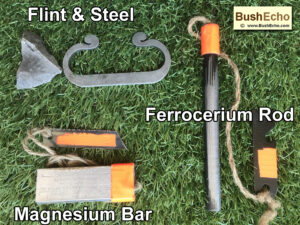
Flint and steel.
The traditional flint and steel is made up of the flint. Which could be a type of hard rock, like quartz, flint or chert, etc. The steel striker portion has a high carbon content and is heat treated. The steel striker is struck against the flint, or vice a versa. (Or iron pyrite rocks can be used with flint.)
When the steel is struck with the rock, the hard rock slices tiny particles of metal off. The iron when exposed to oxygen, oxidizes and ignites. The flint should have a sharp edge to help with the sparks.
The drawback of the flint and steel is, that the sparks created are dull and generally require charred material to catch a spark. Such as char cloth, or natural charred materials, like charred punkwood, cattails, etc.
There are some tinder fungus and plant materials that can take a spark, but usually the tinder range is limited and has to be charred.
Once the spark is caught in the charred material, the ember is transferred to a tinder bundle, or birds nest and then blown into flame.
The value of the flint and steel is that it can be an efficient sustainable method for fire-lighting, with a bit of preparation. (Preparing and charring future fire lighting tinder.)
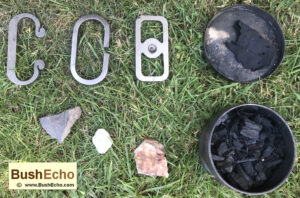
Above picture: A few different designs of flint and steel. A char tin containing charred punkwood bottom right. Top right item, is char cloth on lid. The rectangle steel striker can also be used as the hand piece for the spindle for a bow drill friction fire. It can also be used as a scraper for a ferro rod.
You can char material in a fire without a tin, but the container makes it easier.
The spine on certain high carbon knifes, or an axe, machete, parang, etc., can also be used as well as the steel striker to create sparks.
Tip – Jute twine can make a good tinder bundle, or mix it with natural materials found.
Like friction fire, there is a nice sense of accomplishment when using the flint and steel to create a fire.
If you have issues getting a fire with the flint and steel, check out – Flint and steel troubleshooting. And Flint and Steel Tips.
Ferrocerium Rod. (Ferro Rod.)
The ferrocerium rod is nicknamed, “ferro rod” for short. The ferro rod creates hot sparks, but not an instant flame.
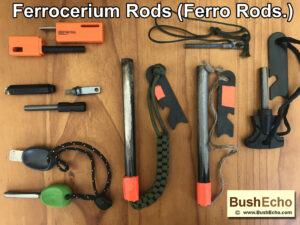
The ferro rod is also called a firesteel, Swedish firesteel, fireflash, metal match and mischmetal, because of the mix of the compositions of metals.
It is occasionally called an artificial flint or flint striker, but it isn’t a flint and steel.
Different brands of ferro rods have different compositions of metals and some may be softer or harder to scrape. There are advantages of both. Like, a softer ferro rod won’t last as long, as more materials are being scraped off it. However, the softer metal allows more to be scraped off and hence more material for potentially greater sparks. (Depending on composition.)
Because the ferro rod doesn’t create a flame, but sparks, most tinder has to be finely processed and ideally dry.
Here are some materials when prepared properly can be used for tinder with the ferro rod: Fatwood, fine feather sticks, birch bark, plant down material like cattail and thistle fluff, bracket fungus, dried pine needles, birds nest, dry grasses, shredded barks, dried herbivore animal dung, etc. Break down these materials more by scraping, tearing, rolling and rubbing into fine particles.
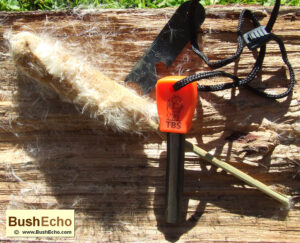
Above pic: TBS ferrocerium rod with cattails for tinder. The cattails are a flash tinder and burns out quickly, so it is better mixed with other dry tinder.
A good combination to have in a survival kit with the ferro rod is, cotton balls, (Or cotton pads.) coated with Vaseline. (Petroleum jelly.) The Vaseline smeared on cotton balls, can be stored in a waterproof snap lock bag, or a film canister for back up tinder.
A larger ferro rod, (5-6 inches long by ½ inch wide.) combined with the back spine of a knife, is easier to scrape and operate when your hands are cold, rather then a smaller ferro rod and small scraper. The larger version also can remove more material when scraped and potentially help with subpar tinder.
Most lanyards that attach the ferro rod to the striker (Scraper.) are too short. I like to replace mine with jute twine or fire paracord for extra tinder options.
You can wrap one end of the ferro rod with bright colored duct tape. This can serve three functions. The bright colored tape is easy to see if the tool is put down or dropped. The tape serves as a handle. Also the tape can be unwrapped and used as a flame extender.
The ferrocerium rod has a black protective coating on it when new, this coating needs to be scraped away before the exposed metal gives a spark.
Magnesium bar fire starter.
The magnesium bar is sometimes called a mag bar for short. The magnesium bar or block, is normally combined with a smaller ferrocerium rod, glued to the top of it.
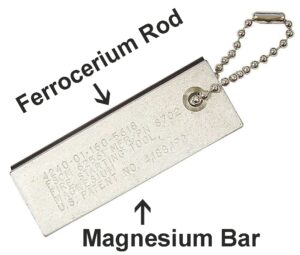
The mag bar fire starter is used by scraping shavings off the magnesium block. The magnesium scrapings are then ignited by a spark from the ferro rod. The magnesium shavings burn extremely hot and help light tinder and kindling.
The metal can be scraped off with the back of the knife spine. (Don’t use your blade edge, as you are blunting the knife and may possible damage it.) Some magnesium blocks will come with a striker, like a hack saw blade attached to it. This helps to shave off the magnesium metal and also helps scrape the ferro rod for a spark.
The shavings can easily blow away from the wind, so scrap off the metal shavings in cover, away from the wind. Or place them in a depression / divot in some wood for a base. This also keeps the materials off the damp ground.
Some pieces of tape to hold the shavings on the adhesive sticky side can be used. The tape can be a cloth tape like Gorilla tape. Which is also can be used as a flame extender. (The tape is handy to have in your layered bushcraft survival kit and part of your 10cs of survivability.)
One drawback of the magnesium bar is that it takes a fair bit of time and effort to scrap off any amount of material, depending on composition. Also you still need a source of ignition, like sparks from a ferro rod to light it.
Most of the ferro rods attached to the mag bar are way too small and many fall off the mag block when using them. With the hacksaw blade for the striker, the saw edge eats up the ferro rod in no time.
An advantage of the mag bar is that the magnesium scrapings are the tinder. Also when ignited, the high temperature may help ignite additional sub-par tinder (Damp, but not wet.) or kindling.
However, for the weight of the magnesium block, as you still need an ignition source, a larger ferro rod and some fatwood might be an alternative.
Beware of the cheap imitation magnesium bar fire starters on eBay, etc. The composition of the block may be poor quality, compared to a good brand mag bar.
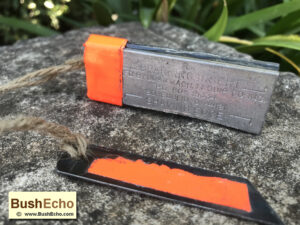
If the magnesium block has a dog chain type metal lanyard to hold the striker on, it can be replaced with jute twine, or fire paracord, for extra fire fuel options.
Summary – The difference between flint and steel, ferro rod and magnesium bar.
I hope this article clears up about the confusion about which fire lighting tool is which and the correct name. Some countries may prefer a name preference, such as a Firesteel instead of a ferrocerium rod, etc.
Overall though a ferro rod and magnesium bar fire starter, is not a flint and steel.
Regardless of what we call the fire lighting tools, because of the limitations of each one, it is always advisable to carry two or more methods in your bushcraft and survival kit. Example, such as a bic lighter, matches and ferro rod, with some dry tinder.

Above picture: Small survival kit tin. Note, the three fire lighting tools and the cotton pads (With Vaseline between then.), fatwood and party trick candles. (More windproof.) The black rubber to hold the lid on the tin, can also be used as a flame extender.
References and Resources. – Essential Bushcraft by Ray Mears, Surviving a Wilderness Emergency by Peter Kummerfeldt, Fire Making by Daniel Hume, Primitive Fire Lighting by Keith H Burgess, 98.6 Degrees The Art Of Keeping Your Ass Alive by Cody Lundin, Wilderness Survival by Gregory Davenport.
Affiliate Links – This article may contain some affiliate product and Amazon affiliate links. This comes at no additional cost to the reader, and helps to support the website. Thank you.
Copyright © by BushEcho. Content on this site cannot be copied and is protected by copyright law. Please contact the author/s for permission.
Disclaimer – This information is for educational purposes only. The author/s and website disclaim liability for any damage, mishap, or injury that may occur from engaging in any activities or ideas from this site.

